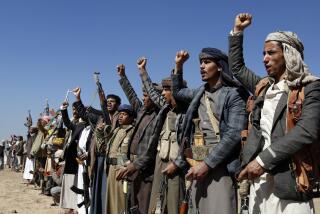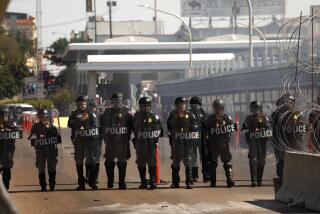U.S. Unveils ‘Most Wanted’ Terrorist List
- Share via
WASHINGTON — President Bush on Wednesday unveiled a list of the world’s 22 “most wanted” terrorists--all Middle Easterners who the administration says have “blood on their hands”--and offered tens of millions of dollars in bounty money to help bring them to justice.
Some of the alleged terrorists have been sought by the U.S. government for as long as 16 years for their roles in anti-American attacks. Sources say at least 14 operatives among the group have apparent links to Osama bin Laden’s Al Qaeda terrorist network.
Bush’s most-wanted list, which will go out on leaflets, matchbooks, the Internet and TV airwaves around the world, offers both the lure of riches to anyone who helps capture the terrorists and the veiled threat of retaliation against nations that may harbor them.
“The real value,” said former Deputy Atty. Gen. Eric H. Holder, “is that the United States has now identified to the world who these terrorists are, and that puts real pressure on those nations who are giving lip service to the notion that they’re against terrorism.”
Bush, in broadening the U.S. wrath to extend beyond Bin Laden, may be seeking to apply particular pressure to officials in Tehran and Baghdad, experts say. U.S. intelligence officials believe that Iran is harboring as many as seven terrorists and hijackers on the list. Iraq is thought to be a safe haven of a most wanted terrorist who was indicted but never arrested in the 1993 bombing of the World Trade Center.
Sen. Orrin G. Hatch (R-Utah), a senior member of both the Senate intelligence and judiciary committees who has been briefed extensively on the Sept. 11 terror probe, said Wednesday that he is “very confident” that Saddam Hussein’s regime in Iraq played a role in last month’s attacks.
Mohamed Atta, the suspected ringleader of the suicide hijackers, is known to have met at least once this year with an Iraqi intelligence official in Europe, a meeting that is drawing scrutiny from U.S. investigators.
Although Hatch would not discuss the basis for his conclusions, he said in an interview that “Iraq has been harboring these terrorists for a long time. . . . I believe that Iraq is ultimately going to be proven to have been a part of this.”
The Bush administration has withheld public judgment on whether it believes Iraq was involved in the Sept. 11 attacks. If Baghdad’s involvement were confirmed, it could open the way for the United States to include Iraq in its anti-terrorist military campaign.
Similarly, some experts say Iran could face military attack by the United States if it does not cooperate in efforts to locate and apprehend terrorists within its borders.
“If there is a highlight here [in the most-wanted list], it is Iran,” said Vince Cannistraro, the former CIA chief of counter-terrorism. “These are wanted people who are hiding in Iran and even being harbored by Iran.”
One of the highest-profile fugitives on the list, besides Bin Laden, is Imad Mughniyah, one of three men indicted in the 1985 hijacking of TWA Flight 847.
Mughniyah, according to Cannistraro and others, lives in Tehran and is affiliated with--and protected by--the Iranian intelligence service.
“Mughniyah is a subsidiary of the Iranian government; a wholly owned subsidiary of Iranian intelligence,” Cannistraro said.
Also believed to be living in Iran are four men who were indicted several months ago for the bombing of the Khobar Towers military housing complex in Dhahran, Saudi Arabia.
Terrorists drove a tanker truck into the complex June 25, 1996, and detonated a powerful explosive, killing 19 U.S. Air Force personnel, wounding 372 others and damaging several military facilities.
Of the 14 men indicted for their roles in that attack, Bush singled out Ahmed Ibrahim Mughassil, Ali Saed bin Ali Houri, Ibrahim Salih Mohammed Yacoub and Abdelkarim Hussein Mohammed Nasser for inclusion on his most-wanted list.
Authorities on Wednesday identified Mughassil as the leader of the terrorist cell that carried out the Khobar Towers attack and said he was among a handful of terrorists most wanted by the U.S. government.
“He has been at the top of the list for years,” said one counter-terror official.
Also on the list are two of Bin Laden’s top lieutenants, Mohammed Atef and Ayman Zawahiri, who were indicted in the 1998 bombings of two U.S. embassies in Africa. They are believed to be with him in Afghanistan.
“If you could pull a trifecta and get Bin Laden, [Zawahiri] and Atef, you deal a serious, serious blow to Al Qaeda and the Egyptian Islamic Jihad,” an organization that has merged with Bin Laden’s network, said one Clinton administration official.
Bush released the list at FBI headquarters. Also present Atty. Gen. John Ashcroft, Secretary of State Colin L. Powell and FBI Director Robert S. Mueller. Bush said the 22 alleged terrorists on the FBI’s new list “do not account for all the terrorist activity in the world, but they are among the most dangerous--the leaders and key supporters, the planners and strategists. They must be found. They will be stopped, and they will be punished.”
Added Powell: “Many of the individuals we are seeking are part of the Al Qaeda leadership. They have blood on their hands from Sept. 11th and from other acts against America in Kenya, Tanzania and Yemen,” the site of the bombing of the destroyer Cole last year, which killed 17 sailors.
The list, which Bush called “the newest weapon in America’s war on terrorism,” is modeled after one of the FBI’s most famous and successful inventions: its “most-wanted” list, thumbtacked onto post office walls and immortalized on TV and in movies.
The FBI’s list has helped authorities capture 438 dangerous fugitives through the years--a 94% success rate.
But U.S. intelligence officials do not know where some of the 22 alleged terrorists are.
“There are other people on that list who--within a ZIP code--we’re pretty sure where they are,” but resistance from harboring nations has prevented their arrests, said one senior law enforcement official.
U.S. authorities hope that the lure of millions in reward money will make a difference.
Since the Sept. 11 attacks, the State Department has increased its reward pot from $5 million to $20 million, with a reward of $5 million for the capture of each man on the list. The names and backgrounds of the 22 fugitives are listed at https://www.dssrewards.net.
The FBI’s Mueller noted that convicted terrorist Ramzi Ahmed Yousef was brought to justice because someone in Pakistan wanted--and was paid--the bounty the U.S. government had placed on him.
Yousef, a Kuwaiti-born munitions expert, had tried to topple the World Trade Center’s towers with a huge bomb. He escaped an FBI dragnet and was in the process of plotting to take down a dozen commercial airplanes when the Pakistani government arrested him. He was later turned over to the U.S. government and convicted of the airliner plot.
However, one federal counter-terror authority questioned the effectiveness of the multimillion-dollar reward campaign, citing several instances where it hasn’t worked.
The official noted that Bin Laden has had a $5-million bounty on his head for years, stemming from his alleged role as the mastermind of the 1998 embassy bombings in Africa.
And Abdelmajid Dahoumane, an accomplice of millennium bomber Ahmed Ressam, also had a $5-million bounty but traveled extensively through Europe and the Middle East for more than eight months and was never turned in.
“Everyone knew who he was, but no one coughed him up,” the official said. “They don’t want to turn in a brother. There was as much money offered for him as for Bin Laden, and nobody dropped a dime.”
Another cautionary note came from Islamic leaders, who questioned why Bush’s most-wanted list featured only Middle Easterners and included no fugitives from terrorist groups within Latin America, Asia or the United States.
“This creates a very troubling perception,” said Ibrahim Hooper, spokesman for the Council on American-Islamic Relations, an advocacy group in Washington. “This list perpetuates the stereotype that while all Muslims may not be terrorists, all terrorists are Muslims.”
More to Read
Sign up for Essential California
The most important California stories and recommendations in your inbox every morning.
You may occasionally receive promotional content from the Los Angeles Times.










